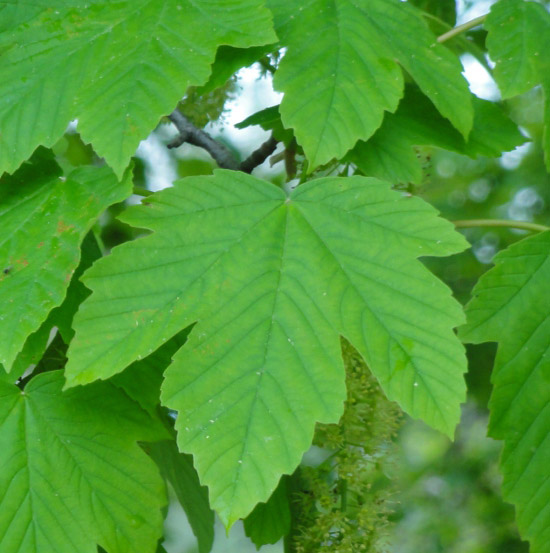
Quick Facts
- Plant Type: Large spreading tree
- Foliage type: Deciduous
- Tree height: 40–60 feet
- Tree width/spread: 25 to 40 feet
- Hardiness: USDA Zones 4 to 7
- Flower Color: Inconspicuous but attractive in mass
- Sun/light exposure: Full sun to part shade
- Water requirements: Tolerates a range of conditions
- Seasonal Interest: None
Sycamore Maple (Acer pseudoplatanus)
This is a maple not a sycamore, but the similarity of its leaves led to its being called Sycamore Maple. It can be easily identified as a Maple by its winged seeds (called samaras). They can also be easily differentiated from a true sycamore by the bark. The Sycamore Maple has grey bark on young trees, becoming rougher with age and breaking up in scales. True sycamores have a smooth bark that peels off in large sections.
The Sycamore Maple is native to northwest and central Europe and western Asia where it is the principal hardwood tree of Europe. The medium-weight white wood is used for making musical instruments, furniture, wood flooring and parquetry.
It was introduced into New York and New Jersey about 1870 and was soon planted in parks in New England and the Mid-Atlantic states. It has escaped cultivation and can crowd out native species. Due the tree’s invasive tendency, it is now prohibited for sale or planting in Connecticut and Massachusetts.
Small, fragrant, pale yellow flowers in mid-spring are inconspicuous by themselves, but somewhat showy when the whole tree is in flower. In contrast to many maples, which are often wind pollinated, the Sycamore Maple is pollinated by insects. The flowers are scented and produce nectar to attract insect pollinators. The flowers are good for honey production.
Sycamore Maple has large leathery dark green leaves that are dull green beneath. The tree is not popular because, unlike native maples, it seldom has good fall color.

